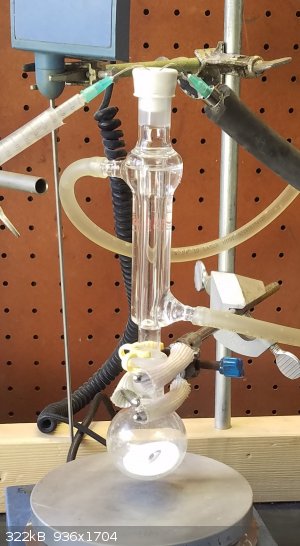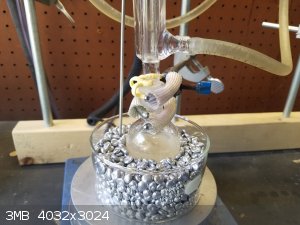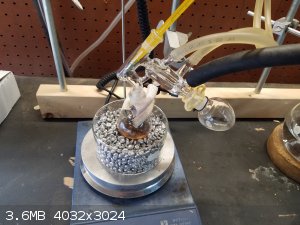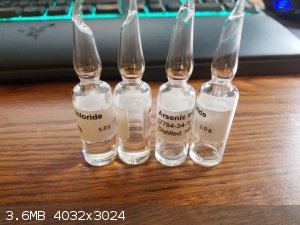numos
Hazard to Others
  
Posts: 269
Registered: 22-2-2014
Location: Pasadena
Member Is Offline
Mood: No Mood
|
|
Preparation of Arsenic trichloride
Took a break from organic chemistry this weekend and decided to make some triphenylarsine to make some Pd complexes with. The first step was to make
arsenic trichloride. Arsenic behaves "similarly" to phosphorus although its compounds are much less studied due to higher toxicity, price, and I
believe they are generally less useful than their phosphorus analogs.
AsCl3 is actually available pretty cheaply if you have access to chemical suppliers. I do not, so I found an old paper than seems to have
made it successfully, and decided to post the results here in case someone else wants to make it. Especially because the prep in the paper only works
well on large scale. While volatile arsenic compounds are probably not the first thing to make in a home lab, I feel that under an inert atmosphere
with good technique and awareness, this procedure can be performed safely and gives access to an interesting arsenic precursor which can be used to
make a plethora of other arsenic compounds.
doi: 10.1002/9780470132623.ch24
The procedure itself was quite simple: arsenic trioxide (10 g) was loaded into a flask with a condenser with septum and then hooked up to argon. An
additional needle was inserted to vent the generated SO2, HCl, and whatever other As crap into a NaOH solution under a constant Ar stream.
Note that I used perfluorinated grease for all joints as these harsh conditions can chew up the silicone stuff.

Thionyl chloride (20 mL) was added over 5 minutes with stirring. An excess is used as it is also solvent. The original prep did this on x10 scale,
and their reaction initiated rapidly and finished within a few hours. I had no such luck and observed no reaction at all for a few hours. I had to
reflux the thionyl chloride for 24 h before all solids dissolved to give a brown solution, indicating completion.

The reaction was cooled and a distillation unit was directly hooked up and rapidly put under Ar. The flask was heated to 120C until no more thionyl
chloride distilled over. The receiving flask was switched out and the AsCl3 was distilled over at 135C (under positive Ar pressure) to yield 17.2 g
(94%) of a dense, colorless oil.

I weighed 12 grams into ampules and sealed them under slight vacuum for later use and will use the remaining 5 grams to make AsPh3. The
liquid is quite water reactive, however, it can be manipulated in air for a few minutes with no problem. The stuff fumes in moist air and I recommend
avoiding all contact with fumes and the liquid.

The excess thionyl chloride and arsenic rinses were neutralized with NaOH and water. I doubt there are any volatile arsenic compounds left in there so
might just evaporate it down and store the solid. Suggestions for what to do with the solid are welcome.
|
|
|
Tsjerk
International Hazard
    
Posts: 3022
Registered: 20-4-2005
Location: Netherlands
Member Is Offline
Mood: Mood
|
|
Nice! Using thionyl chloride as a solvent for arsenic  mad scientistness proven! mad scientistness proven!
|
|
|
njl
National Hazard
   
Posts: 609
Registered: 26-11-2019
Location: under the sycamore tree
Member Is Offline
Mood: ambivalent
|
|
what are those metal pellets you're using for temp control?
|
|
|
Endo
Hazard to Others
  
Posts: 124
Registered: 5-1-2006
Location: USA
Member Is Offline
Mood: Cold
|
|
Those look like Lab Armor aluminum beads.
At one time you could request a free sample.
http://www.sciencemadness.org/talk/viewthread.php?tid=65158
|
|
|
numos
Hazard to Others
  
Posts: 269
Registered: 22-2-2014
Location: Pasadena
Member Is Offline
Mood: No Mood
|
|
I'm actually not sure where they are from, these are inherited. The product Endo mentioned looks spot on, but at the end of the day they are simply
aluminum pellets. While I prefer oil baths at work because they seem to control temp better and are more adaptable to flask sizes, they tend to make a
mess and require that you have lots of hexanes around to clean up residues. This is cleaner and ideal for a home lab.
|
|
|
Boffis
International Hazard
    
Posts: 1836
Registered: 1-5-2011
Member Is Offline
Mood: No Mood
|
|
Nice write-up numos. I have looked preparing tetraphenylasonium salts and this prep requires arsenic trichloride too. Your procedure looks like a nice
clean route, I was planning to use native arsenic and chlorine probably with carbon tetrachloride as a solvent.
I was wondering if its possible to use TCCA or a similar chlorine source directly as a substitute for the hard-to-get thionyl chloride? I can see a
route from TCCA and As but not from As2O3.
|
|
|
woelen
Super Administrator
        
Posts: 7976
Registered: 20-8-2005
Location: Netherlands
Member Is Offline
Mood: interested
|
|
I am surprised to see that some people are capable of doing this type of chemistry in a home lab. I myself have the reagents for this, but I do not
feel sufficiently confident that I can contain the AsCl3 sufficiently well to avoid severe exposure.
What could be done is dissolving chlorine in CCl4 (or CH2Cl2 at low temperature and in dark conditions to avoid chlorination of the CH2Cl2) and adding
solid As to the solution of Cl2. You could bubble in more Cl2 while the reaction is going. I have made solutions of Cl2 in CCl4 and that works very
well. Cl2 dissolves in CCl4 quite well and you can make quite concentrated solutions of this (close to 5% by weight is possible if the CCl4 is cold).
Maybe 5% is too concentrated for the reaction with As. The reaction between Cl2 and As is very exothermic. When a piece of As is immersed in Cl2 gas,
then it becomes so hot that the AsCl3 escapes as vapor and this produces white fumes at a little distance (I tried that, it was scary to know that
there is arsenic-containing vapor around). The solution of Cl2 in CCl4 has a higher chlorine density than chlorine gas, but the solvent of course also
is present and this allows faster/better removal of heat. Just try it on a small scale first.
Making Cl2 from TCCA and passing the dried gas into CCl4 is simple. In my experiments with Cl2 dissolving in CCl4 I used TCCA and dilute HCl and
passed the Cl2 through a tube, filled with CaCl2 from a hardware store. Next, I passed the Cl2 in the CCl4. This results in a perfectly clear yellow
solution. It is not cloudy at all, indicating that it is nicely dry.
It is best to add the HCl in a wide flask (e.g. a round bottom flask), with a stir bar in it, to keep the TCCA moving around. Addition of dilute HCl
to TCCA tends to lead to formation of a lot of foam (solid cyanuric acid) and by sloshing around the solid matter, this foam breaks down and does not
rise high up into the flask.
[Edited on 10-3-20 by woelen]
|
|
|
teodor
National Hazard
   
Posts: 872
Registered: 28-6-2019
Location: Heerenveen
Member Is Offline
|
|
I suspect that in many reaction where you can use AsCl3 you can also try SbCl3. It is very corrosive but not so toxic.
|
|
|
Bedlasky
International Hazard
    
Posts: 1219
Registered: 15-4-2019
Location: Period 5, group 6
Member Is Offline
Mood: Volatile
|
|
Interesting synthesis.
What complexes of Pd with AsPh3 do you made? What do you plan to do with it?
|
|
|
numos
Hazard to Others
  
Posts: 269
Registered: 22-2-2014
Location: Pasadena
Member Is Offline
Mood: No Mood
|
|
Plan to make the analog of Pd(PPh3)4 for use in cross coupling reactions! I think there is precident for this, but want to try for myself.
I definitely saw some preps on directly chlorinating arsenic but it's a messy, nasty reaction. Woelen's chlorine solution might work but is definitely
a more advanced procedure and requires more planning and setup than this. Also Woelen where are you getting your CCl4.... That's a tough one to find!
|
|
|
woelen
Super Administrator
        
Posts: 7976
Registered: 20-8-2005
Location: Netherlands
Member Is Offline
Mood: interested
|
|
Over here, you can still buy CCl4. Not OTC, but there are a few hobby suppliers who are willing to deliver it to private persons.
I personally, however, obtained the CCl4 from someone, who stopped doing home chemistry. I could buy it from this person for a good price.
My procedure is not that advanced. I think that it is easier to do than the prep from As2O3 and SOCl2. Making a solution of Cl2 in CCl4 (or CH2Cl2) is
not that difficult. Just bubble the gas through the liquid and pass it through a tube of dry (anhydrous) CaCl2. I think that if you want to make AsCl3
it may be even better not to prepare a solution of Cl2 first, but just put the As under the solvent and then bubble Cl2 in it. In that case you can
also use CH2Cl2 more easily. The chlorine then only briefly is in contact with the CH2Cl2 and especially if you do this experiment in low light
conditions, the reaction between CH2Cl2 and Cl2 is slow. CH2Cl2 also has a lower boiling point than CCl4, so it is easier to separate this from the
AsCl3.
|
|
|